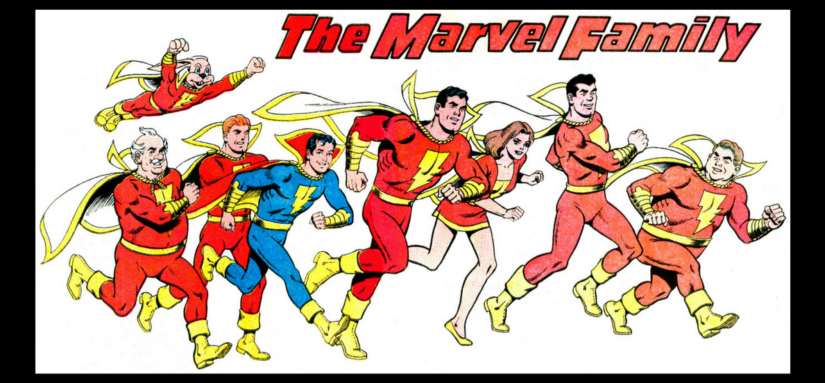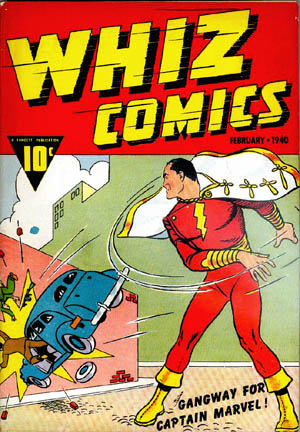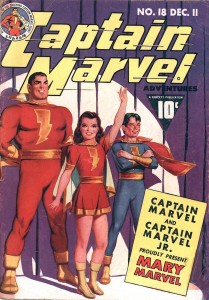The colorful characters who populate the comic pages often have nothing on their creators and publishers. Fawcett Publications, the parent company of Fawcett Comics, was started by one such person. Its founder, Wilford Hamilton Fawcett (or “Captain Billy,” as he was known), was a veteran of the Spanish-American War, a police reporter and a hotelier to the stars, as well as the founder of Fawcett.
Captain Billy launched Fawcett in 1919 with the publication of CAPTAIN BILLY’S WHIZ BANG, a crude, hand-typed pamphlet full of war stories and lewd jokes. The publication, which was originally distributed to disabled veterans, found a huge audience and set Fawcett Publications on the path to publishing success.
One of its successes would come after Captain Billy’s passing, however. Fawcett Comics was launched in 1940 by Fawcett’s two sons, and the company found immense success in the form of the Captain Marvel character created by writer William Parker and artist C.C. Beck. But Captain Marvel, launched in the pages of 1940’s WHIZ COMICS #2, would also be dogged by threats of lawsuits and accusations of plagiarism even as he took the comic world by storm.
Before that, however, the character became one of the most popular characters of the era. Captain Marvel shared many similarities with Superman—as its creators would admit—with the exception that his alter-ego was a young boy, Billy Batson. When Batson spoke the magic word—“Shazam!”—he was transformed into the caped hero Captain Marvel. The character’s popularity quickly won him his own title, CAPTAIN MARVEL ADVENTURES, and led to the expansion of the Marvel family in the form of new characters Captain Marvel Jr., Mary Marvel and even, uh, Hoppy the Marvel Bunny. In the mid-1940s, Captain Marvel’s title even outsold SUPERMAN.
I’ve always felt that it was the ingenious child-to-man transformation concept that made Captain Marvel instantly popular, to the point that it was outselling every comic on the stands throughout the ‘40s. The central concept was one that every kid could get into. First off, the origin was fiendishly appealing: you could never be Superman, since it was pretty clear you weren’t from Krypton, and sure, you could be Batman if you devoted decades of your life to study and training, but who wants to do that? But Captain Marvel? Hey, all that took was shouting a magic word, and instantly you’re a grown-up (and therefore you couldn’t possibly have any problems, right?), super-strong, super-smart, super-brave and you could fly. Oh, and whenever you wanted you could turn back into a kid again. Talk about your wish fulfillment.
Most of the Marvel Family stories were written by Otto Binder, who had a knack for churning out month after month of appealing, straightforward adventure stories with more than a hint of whimsy, which matched perfectly with the cartoony, humorous art of C.C. Beck. The result was a dreamlike romp that combined the fantastic non-logic of fairy tales with the action and adventure of the comic books of the era. And with monthly sales that at times topped one million copies, there must have been plenty who enjoyed the formula.
As you can imagine, competitor National Comics wasn’t overly enamored with this new character that not only looked to be derivative of their Superman character but was also outselling him. National—who had already sued another publisher for a character they developed that seemed too close to Superman—threatened legal action against Fawcett.
In response to the initial cease-and-desist letter from National, Fawcett stopped publishing Captain Marvel’s adventures. But they also realized that the character was too important to the company and so they decided to fight back.
The case took years to get to trial. And you’d think that during that time, someone at National would have actually made sure that their Superman character was copyrighted… but they didn’t, not entirely. So any similarities or differences aside, the judge presiding over the case ruled that National’s copyright to Superman was not protected. Although it wasn’t all good news for Fawcett, since he did also rule that Captain Marvel was illegally copied from Superman.
The news got worse for Fawcett. National appealed the decision (even as they did seem to return the favor and crib certain elements from Captain Marvel, like making Superman actually fly like Marvel did, rather than just “leaping tall buildings in a single bound”), and this time, the decision was reversed. This was at the start of the 1950s, when superhero titles were beginning to fall out of favor for horror comics, and Fawcett deemed the character no longer important enough to fight over. They settled with National, and stopped publishing the character for good.
As Captain Marvel went, so went Fawcett Comics. The publisher cancelled all its superhero titles and laid off all its creators. Many of its characters were sold to Charlton Comics. But Captain Marvel’s story wasn’t entirely over yet. The character laid dormant for two decades, and in that time, the trademark lapsed and Marvel Comics launched a character with the same name. DC Comics later acquired the rights to Fawcett’s character, but now that Marvel owned the trademark to the name, DC’s new titles had to be launched under the name SHAZAM! All of which hopefully helps explain why the character’s actual name was so confusing for kids who saw the character in the live-action Saturday morning show SHAZAM! in the mid-1970s.
Fawcett published a few comics into the 1960s, primarily comics based on or reprinting newspaper strips, but ceased publication soon after. It remains known primarily for its greatest creation, which ironically ended up in the hands of the company responsible for its demise. Holy Moley.




Comments are closed.